


Attack Of The Clones - Part 1
by Jim Mamoulides, April 30, 2004
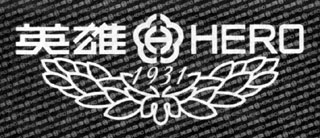
The Times, They Are A Changin'
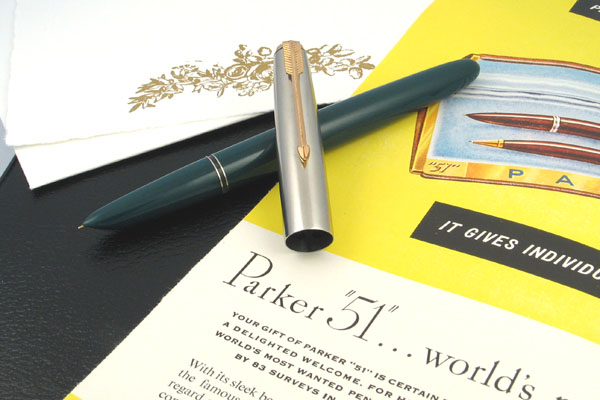
Hero 100 Green
- China
As I write this, the pen world is changing. The last two major USA pen manufacturers are showing signs of serious weakness, one to the point of closing. A. T. Cross, the oldest continuously operating pen manufacturer in the USA, recently has been faced with downsizing and is considering offshoring manufacturing of some of their lines.
Early in 2004, Sheaffer, in business nearly a hundred years, announced that it would close its Ft. Madison, Iowa manufacturing plant in two years. Sheaffer had already been experimenting with offshoring, including some low cost pens and ink manufacturing. Both companies cited declining sales in fine pens. Cross seems to have plans to shrink and split manufacturing between the USA and offshore sources. Sheaffer appears to be on the way to becoming a brand, rather than a company.
Where is the offshore manufacturing going? Much of it may be headed to China. Cross admits this, and some of their new low end products may start coming with "Made in China" labels. Sheaffer, owned by BIC, may turn into a sourced product.
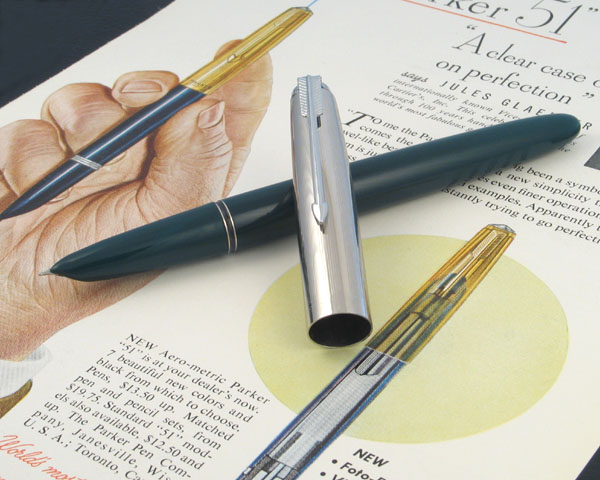
Hero 616 Green - China
Why China? Fountain pens are still widely used in China, much as in Europe, and China has several pen manufacturers that make good quality products for domestic consumption and at a low price. Some of these pens are being imported to the USA, especially those made by the Hero Pen Company, in Shanghai, China.
Today's Hero Group is a diverse multi-industry company, with thirteen subsidiaries, including the manufacture of pens, musical instruments, appliances, windows, and doors. It was founded in 1931 as the Huafu Pen Factory and in 1966 was renamed Hero Pen Factory. Hero pen brands include, Hero, Doctor, Happiness, Huafu, Xinming, Guanleming, Xinhua, and Gentleman.
The Sincerest Form Of Flattery
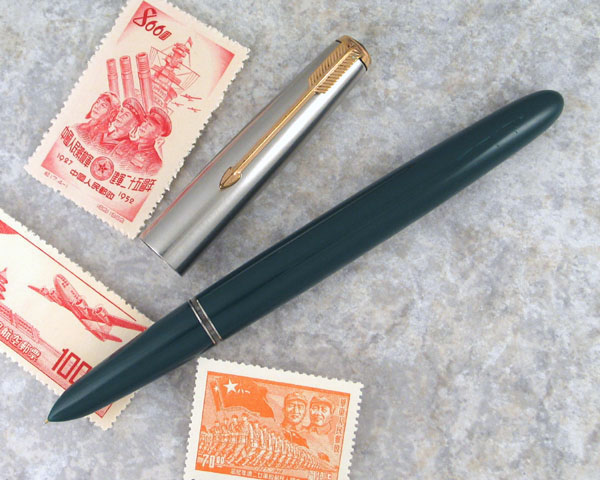
Hero 100 Green - China
Copies of Parker pens have been made all over the world, and none has been copied more than the Parker 51. Since its introduction in 1941, the Parker 51 has been the symbol of the modern age of fountain pens, spanning the end of the Golden Age through the advent of the cartridge / converter pens that are most common today. The Parker 51 was not only immensely popular, but it commanded a high price, a sure magnet for subtle and flagrant copying of the design. Many major pen manufacturers rushed to make something similar in style to the new design leader, but none proved as successful and enduring.
Outright copying is not a new development, and not limited to the Rolex watches that turn up in Times Square in New York City. Several pen companies in China made almost part for part copies of several Parker models, but the Parker 51 was the king of the clones.
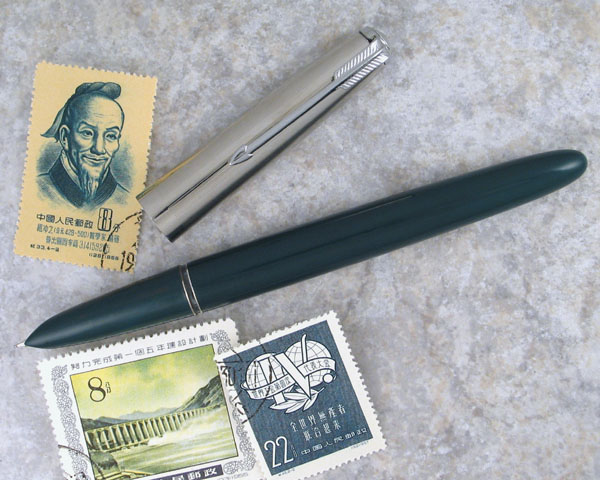
Hero 616 Green - China
Some of these clones suffer badly in the quality department, being made cheaply and with little regard to fit and finish. Others are amazing in their detail and care in manufacture, indicating a real desire to make a good product, copy or not.Like others, Hero made Parker 51 copies, and at both quality endpoints. I had the chance recently to sample a Hero 616, an inexpensive Parker 51 knockoff, and a Hero 100, a more refined pen.
Performance
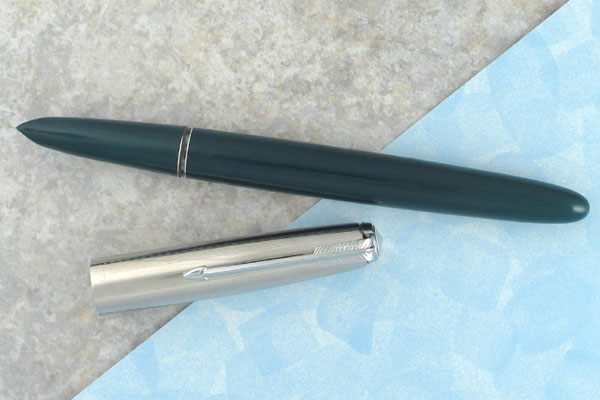
Hero 616 Green - China
The two samples, a Hero 616 and Hero 100, are both Aerometric type copies of the Parker 51. These are older models, and may no longer be in production. I was able to try out both of them extensively as daily users and compared them with two Parkers, a black and a Flighter Aerometric. This gave me the chance not only to review the pens, but also compare them to the original.
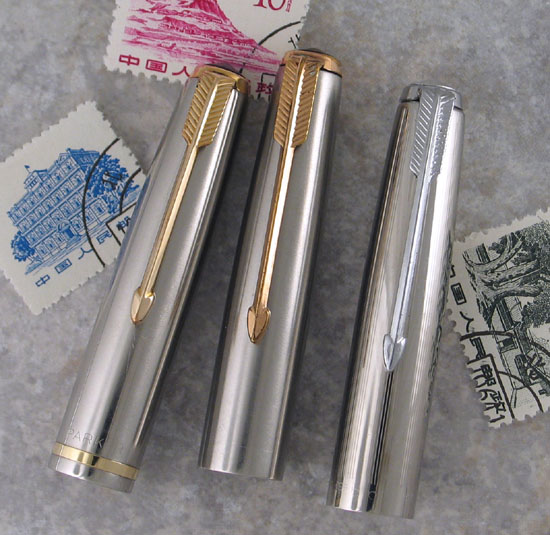
Caps, Left to Right: Parker
51 Flighter / Hero 100 Green / Hero 616 Green
The Hero 616 is a cheap pen. Let's get that out at the top. At a distance, it looks like a green Parker 51 with a highly polished stainless cap. Up close, it has the stamped and slapped together look of cheap toys. The cap actually looks like it may be chrome plated, including the jewel and clip, or a high chrome metal, but definitely not stainless. The lightly engraved pattern of a set of lines and a blank space breaks up the shine, adding some interest to the cap, but it's still a tad gaudy. The fit and finish are fair, with with parts not fitting flush together and no real attention to detail. It looks assembled from parts however they came together. The Aerometric filler looks sloppy and has rough edges. The quality step in the manufacturing process must have been, "Does it write? Ship it!"
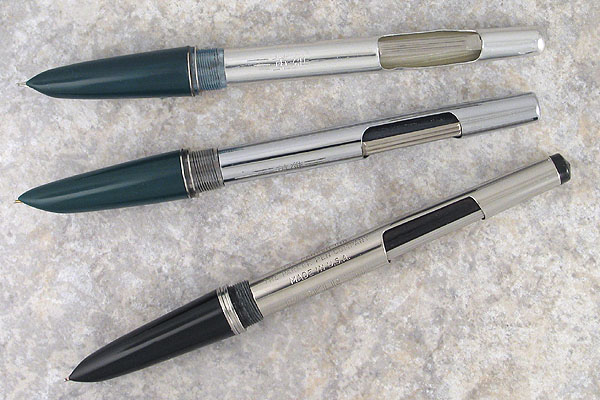
Open, Showing Aerometric
Fillers
Top to Bottom: Hero 616 Green / Hero 100 Green / Parker 51 Flighter
The pen is essentially the same dimensions a vintage 51 Aerometric, about 5 5/8 inches long capped and 6 1/8 inches posted. It's lighter in weight, as both the metal cap and plastic barrel feel a little lighter than their Parker counterparts. Filling is classic Aerometric, unscrew the barrel, stick the nose in the ink bottle, press the bar four to six times for a good fill, wipe, and write. The clutch ring serves as a slender ink window, a nice touch that warns you when the tank is nearly empty.
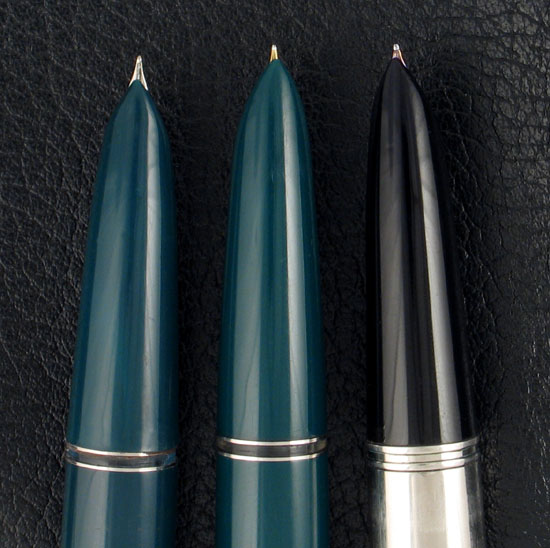
Hooded Nib Detail, Left
to Right: Hero 616 Green / Hero 100 Green / Parker 51 Flighter
I found the extra fine firm nib a tad dry. Its silver color may mean stainless. It wrote a smooth, even line, but with a lot of feedback. No scratchiness, but this is churned butter, not the really smooth stuff. I wrote with it unposted because the cap would not post without the use of excessive force. Not sure what the problem is, but it points back to how the pen was made.The Hero 100 is a definite step up. Every aspect of the pen, essentially the same fundamental design as the 616, including the clutch ring ink window, is executed in a much more high quality way. Unlike the 616, which is like a Times Square US $20.00 Rolex, the 100 looks more like a take on the real thing, with improvements.
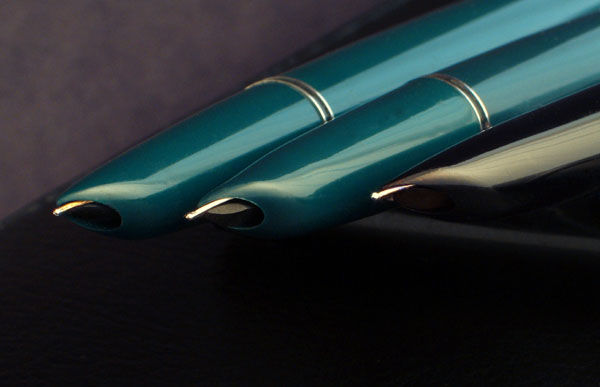
Hooded Nibs, Left to Right:
Hero 100 Green / Hero 616 Green / Parker 51 Flighter
The cap is a heavier brushed stainless, the clip is a well executed gold plate, and the cap jewel though amber, looks right. All the parts fit together correctly. Not quite as well as the original, but a respectable job. The barrel looks suspiciously like the 616 at first. In fact, it looks identical, except for the hint of gold peeking out from the hood. Unscrewed the barrel reveals a much better looking Aerometric filler. This one is much better made. The filler unit is well constructed and operates like the original. Overall, a much better job.Interestingly, the Hero 100 is a little shorter, about 5 3/8 inches long capped and 5 7/8 inches posted. The cap stays on when posted, too. Perhaps the fingers in the 616 cap don't spread out enough and the cap rides too high. The 100 is slightly heavier, owing to the better quality cap. Filling is exactly the same, though the action is better, as expected from the better constructed Aerometric unit. It looks like it has a metal breather tube. This one writes a little wetter and smoother, a fine / extra fine firm nib. More like the real thing, but not quite there. Putting down the 100 and picking up a Parker 51 is a jolt. Though the 100 is a good writer, it's not quite at the Parker level. Good, but not great.
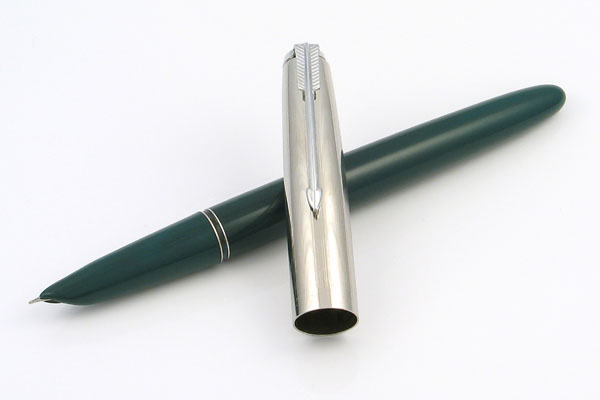
Hero 616 Green - China
Considering that Hero 51 copies can be had for very low prices, they make really good knock around pens. I wouldn't waste money on the 616 and other low quality copies unless you simply have to have anything that looks like a Parker 51. The appeal is the same as collecting cheap Rolexes. What's the point? On the other hand, the 100, and many newer Hero pens are quite well made and write very nicely, representing a real bargain, and may herald the eventual Wal-Marting of the pen business. Let's hope that last thought remains just a thought!
Acknowledgement
Grateful thanks to Dan Carmell for supplying the fun Hero 100 and 616 pens. Dan was not only kind enough to loan the pens, but was also very helpful in supplying background details on them.
Comments on this article
may be sent to the author, Jim Mamoulides
PenHero.com Bibliography